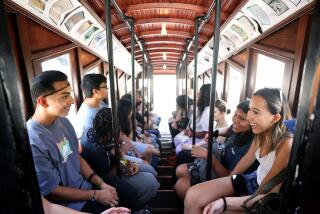Art as a Gateway
Some people painted flowers on the rubble left from the 1992 riots. Artist Judith Baca felt the gesture did not go far enough.
A specialist in “public art,” Baca felt the need for a more culturally focused kind of expression, one that would promote healing and understanding between the splintered communities of Los Angeles.
Her idea, which will begin taking shape late this summer, was to create a series of cultural “gateways” into the three ethnic communities that were hardest hit in the civil unrest: African Americans, Latinos and Korean Americans.
Through a collaboration with members of a Latino art and architecture group and community representatives, Baca developed the idea for “Cultural Explainers,” a series of monuments in public spaces within each of the three communities. She expects that the project will take at least five years to complete.
“Its purpose is to build a monument to a people’s shared experience of culture and to make it readable by the rest of us,” wrote Baca in a booklet about the project, which is being developed through Baca’s Venice-based Social and Public Art Resource Center.
“The form these monuments have taken to ‘explain culture’ is the form of a portal, bridge or gateway.”
The first to be built will be the Koreatown monument, a 25- to 30-foot-high representation of a pyong poong--traditional Korean folding screen--made of metal and concrete in Ardmore Park, where 30,000 Korean Americans gathered just after the riots to show support for their community.
Designed by artist David Chung, the four panels of the screens will depict scenes of Korean American life in shades of celadon blue, the color of most Korean ceramics. Construction is expected to begin within 90 days. Its cost, like those of the other pieces of the gateway project, will depend on yet-to-be determined construction decisions and the level of funding from government and private sources.
The African American monument, which is planned to be located in Leimert Park Village in the Crenshaw district, will be made up of 12 to 14 modern versions of the ancestral poles of the West African Yoruba culture, said Gail Schwartz, associate director of SPARC.
Each pole will be decorated under the direction of artist Pat Ward Williams with objects brought by members of the community, such as photographs, daguerreotypes and musical instruments, Schwartz said.
The poles are to be arranged in a formation that reflects the pattern made by mapping out African American communities in Los Angeles, Schwartz said. Artist Williams is also working on a way to install inside the poles sound elements, such as recordings of oral histories of community residents, that could be activated by sunlight.
The third monument, representing Latino culture, is slated to be built in Alvarado Park in the Pico-Union district, which is made up of Mexican and Central American communities. Baca is collaborating with artist Juan Edgar Aparicio to build a shrine-like structure in the style of the Mayan culture. It will be adorned with nearly life-size figures of street vendors.
*
The interior walls of the shrine will be painted with a “sun mural,” in which light from the sun will create a horizon line that travels across the image. This, says Baca, will express that “we [Latinos] didn’t cross the border; the border crossed us.”
Each of the cultural explainers is being developed using a process in which the idea for the piece is presented to the community in a series of forums. Then, the artist researches the historical background of the community through interviews and collecting photographs, and uses that information to design the monument.
Funding will come from donations by businesses and organizations in the respective communities, as well as grants from the city’s Community Redevelopment Agency.
While each of these public monuments will serve as a marker for communities, Baca said she hopes “Cultural Explainers” will also be used to teach people about each other’s communities.
One way of promoting such multicultural understanding, Baca said, would be creating sighting spots at each monument that would point toward the other two.
More to Read
The biggest entertainment stories
Get our big stories about Hollywood, film, television, music, arts, culture and more right in your inbox as soon as they publish.
You may occasionally receive promotional content from the Los Angeles Times.










